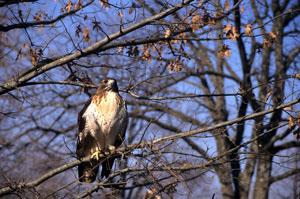Kentucky Afield Outdoors: How wildlife escape snow, ice and cold weather
Published 12:00 am Monday, January 17, 2011

- The population of red-tailed hawks soars in Kentucky during the winter months as migrating birds arrive from the upper Midwest. Animals modify their behavior, hibernate or spend the winter in a state of torpor to survive the ravages of the cold months.
The broad-winged hawk vacations south of the border. Resident Canada geese congregate around open water. Black bear sows den up and give birth. Woodchucks simply go underground and sleep it off.
Those are just a few of the ways wildlife escape the snow, ice and cold weather of winter.
Trending
“The broad-winged hawk nests here but migrates to central and south America for the winter,” said Kate Heyden, avian biologist for the Kentucky Department of Fish and Wildlife Resources.
While most species of hawks in Kentucky never leave their territories, they modify their behavior in winter. It’s harder for birds of prey to find food, so they may gather on a south-facing slope, where the snow is melted away.
“Hawks and owls can get very creative in where they take shelter from the cold, often roosting in barns, or sleeping in thick evergreen trees overnight,” said Heyden.
Red-tailed hawks stay here during the cold weather months, but there’s a big push of migrant birds from the Great Lakes Region, mostly Wisconsin and Michigan.
“We have a lot more hawks in Kentucky during the winter months, and they are much more visible,” Heyden explained.
Resident Canada geese spend the spring and summer raising their young on farm ponds, small lakes and streams across Kentucky. They usually stay close to home when cold weather arrives, but they gravitate to certain areas.
Trending
“They go to bigger water and concentrate on the Ohio River, or Cave Run Lake,” said John Brunjes, migratory bird biologist for Kentucky Fish and Wildlife. Brunjes conducts aerial surveys of waterfowl twice a month in eastern Kentucky from December through February.
“During the big freeze on Dec. 15, I counted 5,860 geese, and on Jan. 4, after the thaw, there were 2,209 geese in the same area,” he said.
He explained that in cold weather geese like to hang around steam plants which have warm water discharges.
“They’re looking for waters that don’t freeze up. As soon as temperatures moderate, they scatter out and go back to small ponds, where they are much harder to count,” he said.
Unlike birds and other wildlife, black bears spend the winter in dens.
“Bears enter a state of torpor, during which their metabolism slows markedly, but they can move around and may even leave their dens,” said Steven Dobey, bear biologist for the department. “They live off their body fat, and don’t eat or drink.”
Sows give birth in their dens and nurse their cubs all winter, emerging in March or April with the little ones in tow. “A bear den may be in a rock crevice, the root wad of a fallen tree, or inside a standing hollow tree,” said Dobey.
While bears spend the winter in a state of torpor, woodchucks sleep away the winter in hibernation.
In October, they go underground for the season to a dead-end nest chamber sealed off with dirt to prevent rabbits and other wildlife from disturbing their slumber.
The woodchuck’s body temperature drops, and its heart rate slows to as few as four beats per minute. They don’t emerge until the first warm days of February.
Other Kentucky wildlife hunkers down.
“Pond turtles, such as the common map turtle or red-eared slider, sit on the bottom of a pond or on the bottom of the river in a backwater area,” said John Macgregor, herpetologist in Kentucky Fish and Wildlife’s non-game program. “On sunny days in February, they might crawl up on a log to get some warmth.”
The rat snake spends the winter in a small mammal burrow, below the frost line.
Imagine being a chipmunk and having to share your home with a big snake four months out of the year.
“Toads burrow down in leaf litter and loose topsoil,” said Macgregor. “Tree frogs might spend the winter in a rotten log or in a hole in a tree.”
The tiny cricket frog, which Macgregor has studied in Mammoth Cave National Park, spends the summer in ponds and wet areas at lower elevations, then moves to upland woods for the winter.
Box turtles dig down in the ground as cold weather approaches. “The colder it gets, they deeper they dig,” said Macgregor.
He is concerned that this past year’s unusual weather may cause a box turtle die-off. “It was a dry summer, and we did not have the rainy weather in the fall we usually get, so turtles couldn’t dig down as far. Then it turned off so cold (in December),” McGregor explained.
White-tailed deer can’t escape winter, so they try to conserve body heat when it’s cold. They feed on high-calorie foods, moving as little as possible, and expending energy only during the warmest parts of the day.
Doesn’t that sound a lot like the human couch potato, curled up in front of the tube watching pro football?
The Kentucky Department of Fish and Wildlife Resources manages, regulates, enforces and promotes responsible use of all fish and wildlife species, their habitats, public wildlife areas and waterways for the benefit of those resources and for public enjoyment. Kentucky Fish and Wildlife is an agency of the Tourism, Arts and Heritage Cabinet. For more information on the department, visit our website at fw.ky.gov.






